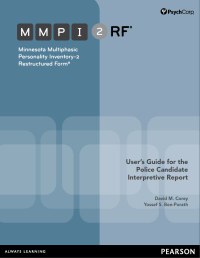MMPI-2-RF Reports
The University of Minnesota Press is pleased to announce the publication of the MMPI-2-RF Police Candidate Interpretive Report!
For additional information or to order the PCIR, visit our distributor, Pearson Assessments.
Meet the Author
 MMPI-2-RF Police Candidate Interpretive Report co-author David Corey, Ph.D. shares details about his background in police psychology and the development of this brand new report:
MMPI-2-RF Police Candidate Interpretive Report co-author David Corey, Ph.D. shares details about his background in police psychology and the development of this brand new report:
How did you first get involved in the public safety sector?
My undergraduate adviser was an early pioneer in police psychology and I had the good fortune of becoming his research assistant. I continued to pursue this area of study in graduate school and conducted my doctoral dissertation research on the use of the MMPI in predicting counterproductive behavior in police officers. Since 1980, my primary area of practice has been in the assessment—both preemployment and fitness-for-duty—of police and public safety personnel.
 What are the three most important things that people should know about the MMPI-2-RF Police Candidate Interpretive Report (PCIR)?
What are the three most important things that people should know about the MMPI-2-RF Police Candidate Interpretive Report (PCIR)?
It’s evidence based (all correlate-based interpretations derive from published studies), transparent (the source for every interpretive statement is identified in the report), and relevant (all interpretive statements pertain to behaviors and performance domains that are meaningful in police work).
What was your primary goal in developing the PCIR?
Our primary goal was to provide users of the MMPI-2-RF with a useful bridge between the science and practice of police candidate screening. The individual psychologist is responsible for assessing a candidate’s suitability for police work based on consideration of test scores, personal history and other collateral information, and clinical observations, but we wanted to facilitate that task by providing easy access to the evidence-based meaning of a candidate’s MMPI-2-RF scores. Test users could certainly access that information on their own through a careful analysis of the published literature, but the PCIR simplifies and standardizes that task.
What advantages did the MMPI-2-RF offer as the instrument from which the PCIR was derived?
First, the MMPI-2-RF’s hierarchical organizing structure overlays nicely onto the common psychological screening criteria for police applicants, with their shared focus on personality and psychopathology. Second, because the MMPI-2-RF derives from a subset of the MMPI-2 items, it was possible for us to conduct longitudinal outcome studies of police candidates who had taken either the MMPI-2-RF or the MMPI-2, which gave us immediate access to a much larger pool of subjects. Third, the accumulating empirical evidence supporting both the psychometric advantages and validity of the MMPI-2-RF made it a compelling choice for the PCIR. Finally, Auke Tellegen and Yossef Ben-Porath had established a commitment to interpretive source transparency in their publication of the MMPI-2-RF Clinical Settings Interpretive Report, which made the PCIR a natural extension of that legacy.
How do I see the PCIR most benefiting today’s police forces?
Psychological screening of police officer candidates occurs in the vast majority of jurisdictions across North America, and in nearly all agencies serving communities of 25,000 or more residents. By contributing to empirically informed and valid selection decisions, it’s our hope that the PCIR can enhance the quality and effectiveness of police officers, reduce the incidence of counterproductive behaviors, and increase public trust.
Additional information on the new MMPI-2-RF Police Candidate Interpretive Report, can be found here.
The MMPI-2-RF® Score and Interpretive Reports provide raw and T scores for all 51 empirically validated scales of the MMPI-2-RF. These reports also enable users to include comparative means and standard deviations for 20 different comparison groups and to create their own customized comparison groups.
MMPI-2-RF Score Report
This report provides scores for all 51 scales of the test in the following profiles:
- Validity Scales
- Higher-Order and Restructured (RC) Scales
- Somatic/Cognitive and Internalizing Scales
- Externalizing, Interpersonal, and Interest Scales
- PSY-5 Scales
MMPI-2-RF Interpretive Report
This report includes full scoring information (see Score Report) and an integrated interpretation of scores organized in the following sections:
- Synopsis – Summary of the major conclusions
- Protocol Validity – Comprehensive information about potential threats to test validity
- Substantive Scale Interpretation – Description of clinical symptoms, personality characteristics, and behavioral tendencies
- Diagnostic Considerations – Diagnostic possibilities indicated by test results
- Treatment Considerations – Recommendations pertaining to treatment planning
- Item–Level Information – List of unscorable responses, critical responses, and user-designated item-level information
- Endnotes – Identification of scores that triggered each interpretive statement
- Research Reference List – Sources of interpretive statements based on empirical correlates
To order the MMPI-2-RF Score or Interpretive Reports, visit our distributor, Pearson Assessments.






